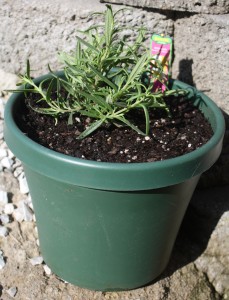If you think growing rosemary is a mystery read the following blog and hopefully it will answer your questions on growing the perfect and happy rosemary.
Rosemary is a tender woody evergreen perennial, which needs to be brought in for the winter if you live in zone 6 and lower. Zone 7 can usually winter over rosemary especially if it is in a protected area.
When bringing rosemary in for the winter just remember rosemary like humidity, does not want to dry out, and hates wet feet. I know confusing. One way to ensure humidity is to mist it daily and only water about once a week or when the top layer has dried out. Another way to achieve humidity is to place it on a bed of gravel and keep the gravel wet. The gravel will keep the rosemary from setting in a wet saucer, which it does not like.
I like to grow rosemary in pots and bring it in for the winter. A pot of rosemary can be sunk in the ground with the top of the pot above ground level and “dug” up for the winter.
How to Grow Rosemary:
Site: Sunny, protect rosemary form cold winds, and it can tolerate light shade.
Soil: needs good drainage. Rosemary likes a lime soil, which will increase its fragrance, but may keep it from growing very tall. Add eggshells to the soil and around the plant. Soil should be about 6.5-7.0 pH.
Propagating: Rosemary does not grow well from seed. The best way is layering or by taking cuttings. If you try seeds, make sure the soil is warm about 70°F.
Growing: Transplant when the plant has several leaves and large enough to take the stress.
Two cultivars: Prostrate and upright. Prostrate Rosemary will grow low to the ground and makes a great plant to grow where it can trail over a wall. The upright will grow about 3 to 6ft. depending on where it is grown.
Harvesting: Pick leaves all summer long, but may want to avoid picking during the winter months. If your are like me and you like to cook with fresh rosemary, take only enough leaves for the dish. For some reason it does not like to be cut much during the winter months.
Preserving: The leaves can be dried either by hanging up or in a food dehydrator. It also works well frozen. The leaves can be tough when dried or frozen so it should be crushed before using. When cutting the branches for harvest always leave about 1/3 of the stem from the base. Cut the stem at an angle just above a nodule. (a nodule is where a new branch or leaf will grow).
Companion planting: Rosemary likes to be planted near cabbages, carrots, sage, broccoli, onions, and beans.
Rosemary may help to repel cabbage worm butterfly, bean beetles, and carrot worm butterfly.
Uses: Rosemary has many uses, one is culinary check out my blog on “Fresh herbs in the Kitchen” or “Fried potatoes with Rosemary and Garlic.” or the article about making vinegar hair rinse.
Use the rosemary stems as skewers when barbecuing.
Rosemary is used in shampoo, hair tonics, facial scrubs, and the essential oil is used in “Hungary water”. Used in cleaning products just to name a few uses of rosemary.
Decorative:Upright Rosemary makes a great plant for topiaries or bonsai. It can be trim especially during the summer to about any shape you like. Use in potpourri and to fragrant linens.
Medicinal: The leaf will stimulates circulation and increases blood flow. When adding to cooking it will aid in the digestion of fats.
Try this wonderful plant with it pungent, pine-like scent and a pepper flavor. The ancient Greeks believe rosemary improve memory and wore wreaths on their head while studying. In the middle ages, sprigs of rosemary was placed under the pillow to ward off evil spirits and to prevent nightmares.
It is known as the herb of Remembrance.
Happy Gardening!

